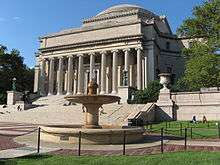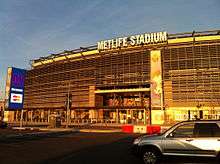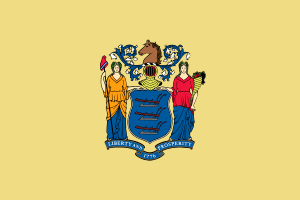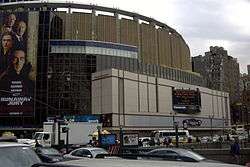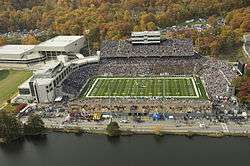Columbia Lions
| Columbia Lions | |
|---|---|
 | |
| University | Columbia University |
| Conference | Ivy League |
| NCAA | Division I |
| Athletic director | Peter Pilling |
| Location | New York, New York |
| Varsity teams | 31 |
| Football stadium | Wien Stadium |
| Basketball arena | Levien Gymnasium |
| Baseball stadium | Hal Robertson Field at Phillip Satow Stadium |
| Soccer stadium | Rocco B. Commisso Soccer Stadium |
| Lacrosse stadium | Wien Stadium |
| Mascot | Roaree the Lion |
| Nickname | Lions |
| Fight song | Roar, Lion, Roar |
| Colors |
Columbia Blue and White[1] |
| Website |
www |
The Columbia University Lions are the collective athletic teams and their members from Columbia University, an Ivy League institution in New York City, United States. The current director of athletics is Peter Pilling.
Ivy League athletics
The eight-institution athletic league to which Columbia University belongs, the Ivy League, also includes Brown University, Cornell University, Dartmouth College, Harvard University, University of Pennsylvania, Princeton University, and Yale University. The Ivy League conference sponsors championships in 33 men's and women's sports and averages 35 varsity teams at each of its eight universities. The League provides intercollegiate athletic opportunities for more men and women than any other conference in the United States. All eight Ivy schools are listed in the top 20 NCAA Division I schools in number of sports offered for both men and women.
The Lions
Columbia University was founded in 1754 and currently fields 31 co-ed, men’s, and women’s teams. Women's teams are cooperatively organized with the affiliated Barnard College.[2] All Columbia teams compete at the Division I level in the National Collegiate Athletic Association (NCAA). The school's football team competes at the NCAA Division I FCS level.
In 1910, the school adopted the lion mascot as a reference to the institution's royal past.[3][4] The University was originally named King's College since its charter in 1754 by King George II of England. The lion is the animal depicted on the English coat of arms. Only after the American Revolution was King's finally renamed Columbia University.
History

Intercollegiate sports at Columbia date to the foundation of the baseball team in 1867.[5][6] Men's association football (i.e. soccer) followed in 1870, and men's crew in 1873. Men's Crew was one of Columbia's best early sports, and in 1878 the Columbia College Boat Club was the first foreign crew to win a race at the Henley Royal Regatta—considered to be Columbia's greatest athletic achievement.[7] The third ever men's intercollegiate soccer match was played between Columbia and Rutgers University, with Rutgers winning 6 to 3. Columbia joined the American football movement soon after Harvard and Yale played their first game in 1875—in 1876, Columbia, Harvard, and Princeton University formed the Intercollegiate Football Association.[8] In addition, the Lions' wrestling team is the nation's oldest.
The Columbia football team won the Rose Bowl in 1934, upsetting Stanford University 7-0. Columbia also hosted the first televised sporting event: on May 17, 1939, the fledgling NBC network filmed the baseball double-header of the Light Blue versus the Princeton University Tigers at Columbia's Baker Field at the northernmost point in Manhattan.[9]
Men’s teams
- Baseball
- Basketball
- Cross country
- Fencing
- Football
- Golf
- Rowing
- Heavyweight rowing
- Lightweight Rowing
- Soccer
- Swimming and diving
- Tennis
- Track and field
- Wrestling
Women’s teams
- Archery
- Women's basketball
- Cross country
- Fencing
- Field hockey
- Golf
- Lacrosse
- Rowing
- Soccer
- Softball
- swimming and diving
- Tennis
- Track and field
- Volleyball
Football
Columbia was one of the first schools to take up the game; Columbia's 1870 contest with Rutgers was the fourth intercollegiate football game ever played.[10]
The Lions compete in the Ivy League, which is part of the NCAA Football Championship Subdivision (formerly known as Division I-AA).
The football program unfortunately is best known for its record of futility set during the 1980s: between 1983 and 1988, the team lost 44 games in a row, which is still the record for the NCAA Football Championship Subdivision. The streak was broken on October 8, 1988, with a 16-13 victory over archrival Princeton. That was the Lions' first victory at Wien Stadium (which was already four years old, having been opened during the streak).[11] Even before the streak, the Lions had long been regarded as one of the worst football teams in the country.
The program was much more successful in the first half of the 20th century, and was at times a national power. The 1915 squad went undefeated and untied.[12] The 1933 edition of the Lions won an unofficial national championship by upsetting the top-ranked Stanford Indians 7-0 in the Rose Bowl on New Years Day 1934. Lou Little, who coached the team from 1930 to 1956, is in the College Football Hall of Fame.
Pro Football Hall of Famer Sid Luckman played his college ball at Columbia, graduating in 1938. Luckman is also in the College Football Hall of Fame.[13] Other Lions to have success in the NFL include offensive lineman George Starke, the Washington Redskins' "Head Hog," during the 1970s and 1980s, quarterback John Witkowski in the 1980s, and defensive lineman Marcellus Wiley in the 1990s. Perhaps the most famous personality associated with Lions football was a running back who had limited success on the field: the writer Jack Kerouac left school and went on the road after one injury-marred season at Columbia. Another Lions back who became legendary for his accomplishments off the gridiron was baseball great Lou Gehrig, who was a two-sport star at Columbia.
Norries Wilson is the first African-American head coach in the history of Ivy League football. He served as the Lions' head coach from 2005 to 2011. Former Penn Quakers football coach Al Bagnoli became Columbia's head coach on February 23, 2015.
Columbia and Cornell play for the Empire Cup, emblematic for Ivy League supremacy in New York State. Beginning in 2018 the will play each other in their season finale.
Beat Dartmouth 9-7 in Homecoming 2016, on October 22, 2016.
Bowl games
| Season | Bowl | Champion | Runner-Up | ||
|---|---|---|---|---|---|
| 1934 | Rose Bowl | Columbia | 7 | Stanford | 0 |
Baseball
Lou Gehrig played college baseball at Columbia (he joined the New York Yankees in 1923, after his sophomore season) as well as Hall of Fame inductee Eddie Collins. In 1939 the first live televised sporting event in the United States, was a Columbia vs Princeton baseball game, broadcast from Baker Field in New York City.[14][15] Other Columbia Lions who have gone on to play in Major League Baseball include Gene Larkin and Fernando Perez. The team plays at Hal Robertson Field at Phillip Satow Stadium, located at the northern tip of Manhattan.
Men's basketball
Columbia was one of the first schools to take up basketball. The Lions' rivalry with the Yale Bulldogs is the longest continuous rivalry in NCAA college basketball (tied with the Yale-Princeton rivalry): the two teams have played each other for 108 seasons in a row, going back to the 1901-1902 season.
The Lions were retroactively recognized as the pre-NCAA Tournament 1904 and 1905 national champions by the Premo-Porretta Power Poll, and as the 1904, 1905, and 1910 national champions by the Helms Athletic Foundation.[16]
During the years just before the Ivy League formally became a sports conference, the Lions made it to "March Madness" on two occasions. In 1948, they were one of eight teams in the tournament, losing in the East regional semifinal to the eventual champion Kentucky. The 1951 team went undefeated in the regular season and were one of the 16 teams invited to the championship. The Lions lost 79-71 to eventual semi-finalist Illinois for a final record of 21-1 (best record in the nation that year with win-loss percentage of .956)[17] The 1951 team is, however, sadly best known for the tragic story of its brilliant but troubled star forward Jack Molinas, who eventually ended up in prison for crimes related his longtime involvement with gambling and who was murdered in 1975 in what appeared to be an organized-crime related assassination. Molinas still holds several school scoring records.
In 1957 Chet Forte was a consensus All-American and UPI player of the year for NCAA Division I; he averaged 28.9 points (fifth in the nation.) He is even more famous for his later work as a producer for ABC Sports, especially on the program Monday Night Football.[17] The 1957 team had 2,016 rebounds, fourth highest in NCAA Division I history, even though they played only 24 games.[17]
The Lions have only won the official Ivy League championship once, in 1968, when they reached the "Sweet Sixteen" in the NCAA national tournament. Two members of the 1968 team went on to play professional basketball: Jim McMillian and Dave Newmark. (NFL great George Starke was also a member of the Lions' basketball team in that era.) Jack Rohan was voted Coach of the Year in 1968.
The Lions had a powerful squad in the late 1970s, even though they never won the Ivy League championship or made it to post-season play. In 1979, the diminutive point guard Alton Byrd won the Frances Pomeroy Naismith Award, given to the best player under 6 feet in height.[17] Byrd never made it to the NBA, but he moved on to a legendary career in European pro basketball.
Women's basketball
Until the 1980s, the women's basketball team (like the other women's teams) was known as the Barnard Bears, playing under the aegis of Columbia's affiliated undergraduate women's college, Barnard College. When Columbia College went co-ed in 1983, the schools formed the Columbia-Barnard Athletic Consortium, and today all Barnard athletes compete on Columbia teams.
The women's basketball team joined the Ivy League in 1986-1987, and for many years were a perennial cellar dweller, reaching their low point in 1994-1995, when they went 0-26. They had never finished higher than fourth in the league standings in their first 23 seasons. In 2009-2010, however, they finished third, putting together a 9-5 record in the Ivy League, and, at 18-10 overall, their first winning season.
Men's and women's soccer
Columbia's soccer program traces its origins to the same Columbia-Rutgers game that the gridiron football program counts as its first contest. (The 1870 Columbia-Rutgers game was played by a set of rules which combined elements of present-day soccer and rugby.) The Lions soccer team has a long history of success, spanning three centuries, highlighted by national collegiate championships in 1909 and 1910 (Intercollegiate Soccer Football League), and a second-place finish in the 1983 NCAA championship.[18][19] Dieter Ficken was named NSCAA Coach of the Year in 1983 after the Lions' 1-0 double-overtime finals loss to seven-time champion Indiana University.[19] 18 Lions players have been first-team all-Americans, and Amr Aly earned the 1984 Hermann Trophy national player of the year award.
The women's team was the 2006 Ivy League champions.
Women's cross-country
- Caroline Bierbaum won the 2005 women's cross country Honda Sports Award (most outstanding NCAA women's cross country athlete of the year) and was NCAA Division I runner-up with a time of 19:46.0[20][21]
- Top-25 national finishes from 2000 through 2005[20]
- Five straight Heptagonal Ivy League Championships: 2001, 2002, 2003, 2004, and 2005
Fencing
- Coed NCAA champions: 1992, 1993, 2015 and 2016[22]
- Coed NCAA runners-up: 1990 and 1991[22]
- 7 coed individual national championships[22]
- 6 coed weapon team national championships[22]
- 16 top-6 coed national finishes in 17 years, 1990-2006[22]
- Men's NCAA champions: 1951, 1952, 1954 (tied), 1955, 1963, 1965, 1968, 1971 (tied), 1987, 1988, and 1989[23]
- Men's NCAA runners-up: 1956, 1957, 1958, 1970, and 1986[23]
- 21 men's individual national champions[23]
- Women's NCAA runner-up: 1989[23]
- 2 women's individual national champions[23]
Men's golf
- A.L. Walker, Jr., NCAA champion, 1919[24]
- Ivy League championships (since 1975): 1999, 2008, 2009, 2010, 2014[25]
Men's rowing

Columbia's first intercollegiate regatta dates back to 1873, when it raced a six-oared shell in Springfield, Massachusetts.[26] The next year, Columbia won the intercollegiate title at Saratoga.[26]
- In 2016, the men's varsity lightweight eight won gold medals at the Intercollegiate Rowing Association National Championships. The men's varsity lightweight 4+ earned bronze medals, enabling Columbia to win the IRA Lightweight Team Trophy.[27] The varsity lightweights eight went on to reach the quarterfinals of the Temple Challenge Cup at the Henley Royal Regatta.[28]
- In 2015, both the men's varsity lightweight eight and the varsity lightweight four took the silver at the Intercollegiate Rowing Association National Championships and reached the semifinals in the Temple Challenge Cup at the Henley Royal Regatta in Henley-on-Thames, UK.[29]
- In 2014, the men's varsity lightweights took the bronze at the Intercollegiate Rowing Association National Championships.[30]
- In 2008, the men's heavyweight crew had a regular season record of 10-1 and finished sixth in the nation at the Intercollegiate Rowing Association National Championship being the only Ivy League school in the Grand Final. They then went on to be the only American crew competing for The Ladies' Challenge Plate at the Henley Royal Regatta.[31]
- The 2003 varsity lightweights went 11-2, gained silver medals after finishing second in both the Eastern Sprints and the IRA National Lightweight Championship, and became the first Columbia crew ever to capture all four cup races in a single season.[32]
- In 2000, the varsity lightweights won the Eastern Sprints, the first time a Columbia varsity has captured the prestigious event, and earned a bronze medal at the Intercollegiate Rowing Association National Championship. The same year, it won England’s Marlow Regatta and took its second trip to Henley in three years, again reaching the quarterfinals.[32][33]
- In 1998 the varsity lightweights won silver medals at the Intercollegiate Rowing Association National Championship, won England's Reading Town Regatta and reached the quarterfinals of the Temple Challenge Cup at the Henley Royal Regatta.[34][32][35]
- In 1995, the freshman lightweights earned Columbia’s first Eastern Sprints medal in 24 years, and were named the EARC Outstanding Lightweight Boat of the Year. The next year, the varsity lightweights earned national acclaim when they went 10-1 and won the Augusta Regatta, the Geiger Cup, and the Subin Cup, and were third in the IRA Regatta—the first Lion varsity crew to medal at the Intercollegiate Rowing Association National Championships in 25 years.[32]
- In 1971, Columbia’s varsity lightweight crew won a silver medal at Eastern Sprints. The crew competed at the Henley Royal Regatta where they advanced to the semifinals in the Thames Challenge Cup.[36][37]
- In 1964, the freshman lightweight crew had a perfect season, winning all five of its regular season races, and won a gold medal at Eastern Sprints by two-tenths of a second.[38]
- In 1928, the varsity lightweights won the Joseph Wright Challenge Cup at the American Rowing Association Regatta—also known as the American Henley Regatta, and generally regarded as the lightweight national championships[39]—on the Schuylkill River, by five boat-lengths.[40][41] In 1929 the varsity lightweight eight was undefeated in match racing, and captured 2nd place at the American Henley before traveling to England where they won the Marlow Regatta and made it to the semifinals of the Thames Challenge Cup at the Henley Royal Regatta.[42][43][44] It was Columbia's first return to Henley since their 1878 victory, and it marked the first-ever appearance of a lightweight crew at Henley.[44][45] They were the first lightweight crew to be awarded a Varsity "Major C" for creating a favorable impression abroad and adding rowing honors to Columbia and to the sport in the United States.[46]
- In 1895, with Cornell and Penn, the Lions competed in the first-ever race for the college championship and finished first. This would come to be known as the Poughkeepsie Regatta, a competition to award the national intercollegiate rowing crown. Presently, this race is known as the Intercollegiate Rowing Association Regatta. The Varsity 8s also won the regatta in 1914, 1927, and 1929[10][47]
- In 1879 the varsity 4 won the Rowing Association of American Colleges Regatta on Lake George.[47]
- In 1878 the Columbia College Boat Club won the Visitors' Challenge Cup for coxless-fours at the famed Henley Royal Regatta to become the first foreign crew to win a cup at the regatta (1st Race, defeated University College, Oxford; final, defeated Hertford College, Oxford)[10][45][48][49]
- In 1874 the Varsity 6 won the Rowing Association of American Colleges Regatta on Lake Saratoga.[47]
Men's swimming and diving
- Head Coach: Jim Bolster
- 8 individual NCAA Division I championships
Historical note:
1976 - First & only female varsity athlete at Columbia (before Columbia College began admitting women): Annemarie McCoy competed against the Lions' opponents.[50] Thanks to Title IX, all Columbia University students (including those women from The School of Engineering and Applied Science) were eligible for Columbia athletic programs—and so McCoy was able to stay afloat with her teammates.
Women's swimming and diving
- Head Coach Diana Caskey and Assistant Coach Demerae Christianson
- 2013-2014 Ivy League Dual Meet Championship Team
- 4 individual NCAA Division I championships
- Cristina Teuscher, 1999-2000 Honda-Broderick Cup winner (NCAA Collegiate Woman Athlete of the Year)[51]
Men's tennis
- Ivy League Champions 2009
- Ivy League Champions 2007
- NCAA Division I tournament appearances, 1984, 1987, 1998, 2000[52]
- Robert LeRoy, two-time NCAA singles champion, 1904 and 1906[52]
- Oliver Campbell and A.E. Wright, NCAA doubles champions, 1889[52]
- Oliver Campbell and V.G. Hall, NCAA doubles champions, 1888[52]
Men's track and field
- 3 outdoor track and field individual NCAA Division I championships
- Once sported the world's fastest man, Benjamin Washington Johnson, the Columbia Comet.[53] The sprinting champion's most incredible achievement was at the 1938 Millrose Games, in front of more than 17,000 fans at Madison Square Garden. His winning time in the 60 yard dash was 5.9 seconds, breaking the world record of 6.2 seconds for the third time in the same day. His final time of 5.9 seconds was rounded up to 6.0 seconds, because the referees claimed it must have been a timing error, arguing that no human being could ever break 6 seconds in the 60 yard dash.
- In 2007, Columbia won the Championship of America 4 × 800 m race at the prestigious Penn Relays. The team of Michael Mark, Jonah Rathbun, Erison Hurtalt, and Liam Boylan-Pett ran 7:22.64, outkicking the anchor legs of national powerhouses Michigan, Villanova, and Oral Roberts. The team has finished no lower than fifth in the past three years.
- In March 2010, Kyle Merber became the first Columbia athlete to break four minutes in the mile, running 3:58.52 at the Columbia Last Chance Meet at the 168th St. Armory. The mark is also an Ivy League indoor record.
Wrestling
Dating back to 1903, wrestling has a history at Columbia. Since 2011, Carl Fronhofer has been head coach of the Lion Wrestling team which currently competes in the EIWA Conference. There has been 19 EIWA Conference Champions and 5 NCAA All-Americans, most recently to Matt Palmer who placed 8th in 05' & 07' and Steve Santos who placed 3rd in 13' at the NCAA Wrestling Championships.[54] The Blue Gym (or University Gym) is located within the Dodge Physical Fitness Center on campus which is home to the Columbia Lion Wrestling team.
NCAA team championships
As of March 27, 2016, Columbia has 15 NCAA team national championships.[55]
- Men’s (11)
- Fencing (11): 1951, 1952, 1954, 1955, 1963, 1965, 1968, 1971, 1987, 1988, 1989
- Co-ed (4)
- see also:
Notable athletes
The Lions have produced such notable athletes as:
- Amr Aly - Soccer
- Eddie Collins - Baseball
- Chet Forte - Basketball
- Lou Gehrig - Baseball
- Paul Governali - Football
- Erison Hurtault - Track and Field
- Gene Larkin - Baseball
- Jim McMillian - Basketball
- Sid Luckman - Football
- Erinn Smart - Fencing
- Marcellus Wiley - Football
References
- ↑ "Logo – Columbia University in the City of New York". Retrieved 2016-04-01.
- ↑ "Athletics". barnard.edu.
- ↑ The American College. Higher Education Association. 1910. p. 162.
- ↑ The Christian Work and the Evangelist. 1910. pp. 122–.
- ↑ "About College". Columbia Spectator (Vol XL, No 9). New York, NY: Columbia Spectator. 6 April 1897. p. 96. Retrieved 8 July 2016.
- ↑ "On the Sidelines: Diamond History". Columbia Spectator (Vol LXVI, No 69). New York, NY: Columbia Spectator. 26 March 1943. p. 3. Retrieved 8 July 2016.
- ↑ "Sidelines". Columbia Spectator (Vol LVIII, No 92). New York, NY: Columbia Spectator. 7 March 1935. p. 3. Retrieved 8 July 2016.
- ↑ Harvard Athletics: A Timeline of Tradition
- ↑ Baker Field: Birthplace of Sports Television Archived October 7, 2008, at the Wayback Machine.
- 1 2 3 C250 Celebrates Columbia Athletics: Columbia Athletics Highlights
- ↑ http://www.wikicu.com/Losing_streak
- ↑ NCAA Records Books: Football Records - 2006 Division I-A/I-AA Football Records Book Archived December 22, 2006, at the Wayback Machine.
- ↑ NCAA Records Books: Football Records - NCAA Division I-A Football's Finest
- ↑ "Sportscasting Firsts: 1920 - Present". AmericanSportscastersOnline.com. Archived from the original on May 5, 2013. Retrieved May 5, 2013.
- ↑ "Sports and Television". Museum of Broadcast Communications. Archived from the original on May 5, 2013. Retrieved May 5, 2013.
The first televised sporting event was a college baseball game between Columbia and Princeton in 1939, covered by one camera providing a point of view along the third base line.
- ↑ ESPN, ed. (2009). ESPN College Basketball Encyclopedia: The Complete History of the Men's Game. New York, NY: ESPN Books. pp. 530–31. ISBN 978-0-345-51392-2.
- 1 2 3 4 NCAA Records Books: Basketball Records Archived March 23, 2007, at the Wayback Machine.
- ↑ College Soccer Championships www.sover.net. URL accessed February 9, 2007
- 1 2 NCAA Records Books: Soccer Records Archived June 14, 2007, at the Wayback Machine.
- 1 2 NCAA Record Books: Cross Country Records
- ↑ Columbia's Caroline Bierbaum Wins Honda Award www.sover.net. URL accessed March 4, 2007
- 1 2 3 4 5 NCAA Records Books: Fencing Records
- 1 2 3 4 5 Official 2002 NCAA Winter Championships Records Book: Discontinued Championships Archived June 25, 2008, at the Wayback Machine.
- ↑ NCAA Records Books: Golf Records
- ↑ "The Ivy League Men's Golf Records Book 2012–13" (PDF). Retrieved June 26, 2013.
- 1 2 The Undergraduate Record: Columbia College. A Book of Statistical Information. Gillis Bros. 1881. pp. 146–.
- ↑ "Lightweight Rowing Claims National Championship at IRA's". Columbia University Athletics. 5 June 2016. Retrieved 5 June 2016.
- ↑ "Lightweight Rowing Felled by Oxford Brookes in Henley Quarterfinals". Columbia University Athletics. 1 July 2016. Retrieved 1 July 2016.
- ↑ "Lightweight Varsity Eight Edged by Université de Lyon to End Henley Run". Columbia University Athletics. 4 July 2015. Retrieved 4 April 2016.
- ↑ "Lightweights Make Lion History with Gold and Bronze Medals at IRA National Lightweight Championships". Columbia University Athletics. 1 June 2014. Retrieved 4 April 2016.
- ↑ "Crew Travels to England for Henley Royal Regatta". Columbia Spectator (Vol CXXXII, No 70). New York, NY: Columbia Spectator. 4 September 2008. p. 10. Retrieved 25 June 2016.
- 1 2 3 4 "Rowing in New York City" (PDF). Columbia Athletics. Columbia University. Retrieved 3 April 2016.
- ↑ "2000 Eastern Sprints Regatta Results". Eastern Sprints Regatta Results. Eastern College Athletic Conference. Retrieved 3 April 2016.
- ↑ "Varsity Lightweight Lion Eight Earned Trip to the Thames". Columbia Spectator (Vol CXXII, No 81). New York, NY: Columbia Spectator. 11 September 1998. p. 10. Retrieved 25 June 2016.
- ↑ A. Dunlap-Smith (12 June 1998). "Men's Crew Finishes 2nd in the Nation". Columbia University Record (Vol 23, No. 24). New York, NY: Columbia University. Retrieved 3 April 2016.
- ↑ John E. Mulligan III ’72 (March–April 2007). "Masters of the Harlem River". Columbia College Today. Retrieved 3 April 2016.
- ↑ "Abele New Head of Crew Program". Columbia Spectator (Vol CXVI, No 6). New York, NY: Columbia Spectator. 6 October 1971. p. 8. Retrieved 25 June 2016.
- ↑ Martin M. Goldstein ’67 (May–June 2007). "A Season to Remember". Columbia College Today. Retrieved 3 April 2016.
- ↑ "Lion Lightweights To Row Tomorrow In Annual Classic". Columbia Spectator (Vol LI, No 150). New York, NY: Columbia Spectator. 25 May 1928. p. 1. Retrieved 7 June 2016.
- ↑ Robert F. Kelley (May 27, 1928). "COLUMBIA'S EIGHT SCORES IN HENLEY". The New York Times. Philadelphia: The New York Times. pp. 141, 145. Retrieved 3 April 2016.
- ↑ "Lion 150's Triumph In American Henley, Score Five-Length Victory". Columbia Spectator (Vol LI, No 151). New York, NY: Columbia Spectator. 28 May 1928. p. 1. Retrieved 7 June 2016.
- ↑ "150'S WILL EMBARK FOR ENGLISH RACES". Columbia Spectator (Vol LII, No. 144). New York, NY: Columbia Spectator. 4 June 1929. p. 1. Retrieved 3 April 2016.
- ↑ David A. Boehm (22 March 1932). "Lightweights Show Promise With Seven Frosh in Shell". Columbia Spectator (Vol LV, No 106). New York, NY: Columbia Spectator. p. 1. Retrieved 3 April 2016.
- 1 2 "150-Pound Columbia Crew to Row Abroad". The New York Times. New York: The New York Times. May 10, 1929. p. 31. Retrieved 3 April 2016.
- 1 2 Thomas E. Weil. "A Brief Time-Line of Rowing". Retrieved 4 April 2016.
Columbia’s entry in the Thames Cup marked the first appearance of a lightweight crew at Henley.
- ↑ "COLUMBIA HONORS LIGHTWEIGHT CREW". The New York Times. New York: The New York Times. December 10, 1929. p. 42. Retrieved 3 April 2016.
- 1 2 3 "Intercollegiate Rowing Association Regatta Results". Friends of Rowing History. Retrieved 4 April 2016.
- ↑ Thomas E. Weil. "U.S. Winners at Henley Royal Regatta". Retrieved 4 April 2016.
- ↑ "THE VICTORY IN ENGLAND". The New York Times. New York: The New York Times. July 17, 1878. p. 2. Retrieved 3 April 2016.
- ↑ http://spectatorarchive.library.columbia.edu/cgi-bin/columbia?a=d&d=cs19760206-01.2.25&srpos=493&e=-------en-20--476--txt-txIN-swimming-ILLUSTRATION----
- ↑ The Collegiate Women Sports Awards
- 1 2 3 4 NCAA Records Books: Tennis Records
- ↑ http://www.ivyleaguesports.com/article.asp?intID=4238
- ↑ "Columbia Wrestling History" (PDF). Lion Athletics. Retrieved 2014. Check date values in:
|access-date=(help) - ↑ http://fs.ncaa.org/Docs/stats/champs_records_book/Overall.pdf
- ↑ http://www.ivyleaguesports.com/sports/mfencing/2014-15/releases/Columbia_Claims_NCAA_Fencing_Championship
